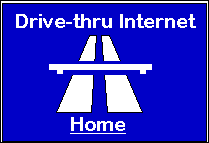Drive-thru MotivationUbiquitous network connectivity - anywhere, anytime - for mobile users and permanent access to the Internet as well as to corporate or private networks has driven many developments in the communications industry over the past years, manifested in the rapid growth and evolution of cellular wide-area networks (such as GSM, GPRS, and UMTS) and wireless local area networks (WLANs, 802.11b/a/g). While cellular networks aim at full coverage (at least in most parts of a country), WLANs are to provide selected hot spots of connectivity, sometimes also covering larger areas such as enterprise premises or university campuses. Because they strive for full - permanent - connectivity, cellular networks may be referred to as perma-nets, WLAN hot spots providing only occasional islands of connectivity as nearly-nets. The basic motivation is the same for either type of network: access to public and private online resources; the capability to communicate with co-workers, friends, and family; and, increasingly, to enjoy online entertainment. But arrangements, cost, and services differ: Permanets are expensive to build and maintain, the user base consists of paying subscribers, cost is significant (and thus accounting is important), and the service in terms of affordable bandwidth available for IP communications is limited to some 10 to about 100 kbit/s (GSM to UMTS). In contrast, WLANs offer only local coverage but provide shared gross data rates from 10 to 50 Mbit/s and have proven to scale to several hundreds concurrently active users when designed properly (as can e.g. be seen from IETF meetings). They support various usage scenarios, with different authentication and tariff models:
Irrespective of how they are managed, today, WLAN-based hot spots can provide a cost-effective and powerful wireless Internet access. However, access is largely limited to local geographic coverage and often to indoor environments. The today less widespread outdoor access for mobile users often comes as a side effect from WLANs inside buildings or from a rather limited number of dedicated access points, e.g. in parks, on campuses, or co-located with public phones. But extending WLANs to public (outdoor) places has brought up additional service ideas beyond plain network access: city, shopping, and restaurant guides with location-based services, free access to local information in malls (e.g. advertisements), finding nearby buddies, among others. But today's deployments of WLAN-based access technology are mostly limited to rather stationary users: indoor users who are mobile but within a rather limited range and outdoor users who are expected to stop by (in a café or a park area) or to move at most slowly to use the WLAN. Only two types of scenarios for mobile users have also been considered: 1) Providing network services in mobile environments (e.g. airplanes, trains), relative to which the user does not move. 2) Investigating ad-hoc networking scenarios in which several mobile users use WLANs to establish cooperation environments -- but without providing Internet access. In [1], Esbjörnsson et al. provide a description of an application for WLAN-based ad-hoc communication between vehicles and in [2], Singh et al. provide some initial measurement results for inter-vehicle ad-hoc communication, however, without considering TCP and communication between a mobile host and hosts on the global Internet. The Fleetnet project has also focused on wireless ad-hoc communication between vehicles but has also investigated the use of ad-hoc communication as a means to extend the reach of existing network infrastructures. In the Drive-thru Internet project, we investigate the usability of providing network connectivity and, ultimately, Internet access to mobile users in vehicles. The idea of Drive-thru Internet is to provide hot spots along the road - within a city, on a highway, or even on high-speed freeways such as autobahns. They need to be placed in a way that a vehicle driving by will obtain WLAN access for some (relatively short) period of time; if located in rest areas, the driver may exit and pass by slowly or even stop to prolong the connectivity period. One or more locally interconnected access points form a so-called connectivity island that may provide local services as well as Internet access. Several of these connectivity islands along a road or in the same geographic area may be interconnected and cooperate to provide network access with intermittent connectivity for a larger area. While this type of networking environment also constitutes some kind of nearlynet as traditional hot spots do, it displays significantly different characteristics due to the usually short-lived connectivity periods. We expect implications for communications at all layers: wireless link, network (IP), transport, and application layer. In this paper, we focus on plain WLAN connectivity and transport protocol behavior -- and only briefly address implications on applications in the end. Our goal is to prove that WLAN technology is capable of enabling Drive-thru Internet access in the first place and to document the communication characteristics we have observed with different measurement configurations using UDP and TCP as standard transport protocols. Detailed information, including measurement results and the description of a proposed Drive-thru Internet architecture can be found in our publications.
|
|
 |
|



